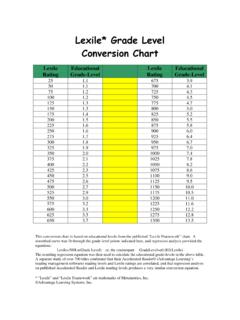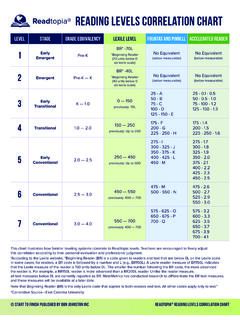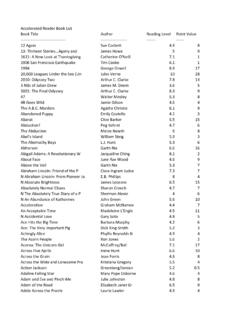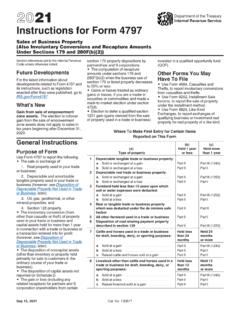Transcription of algorithms
1 An overview of gradient descent optimizationalgorithms Sebastian RuderInsight Centre for Data Analytics, NUI GalwayAylien Ltd., descent optimization algorithms , while increasingly popular, are oftenused as black-box optimizers, as practical explanations of their strengths andweaknesses are hard to come by. This article aims to provide the reader withintuitions with regard to the behaviour of different algorithms that will allow herto put them to use. In the course of this overview, we look at different variants ofgradient descent, summarize challenges, introduce the most common optimizationalgorithms, review architectures in a parallel and distributed setting, and investigateadditional strategies for optimizing gradient IntroductionGradient descent is one of the most popular algorithms to perform optimization and by far themost common way to optimize neural networks.
2 At the same time, every state-of-the-art DeepLearning library contains implementations of various algorithms to optimize gradient descent ( s2, caffe s3, and keras 4documentation). These algorithms , however, are often used asblack-box optimizers, as practical explanations of their strengths and weaknesses are hard to article aims at providing the reader with intuitions with regard to the behaviour of differentalgorithms for optimizing gradient descent that will help her put them to use. In Section 2, weare first going to look at the different variants of gradient descent. We will then briefly summarizechallenges during training in Section 3. Subsequently, in Section 4, we will introduce the mostcommon optimization algorithms by showing their motivation to resolve these challenges and howthis leads to the derivation of their update rules.
3 Afterwards, in Section 5, we will take a short look atalgorithms and architectures to optimize gradient descent in a parallel and distributed setting. Finally,we will consider additional strategies that are helpful for optimizing gradient descent in Section descent is a way to minimize an objective functionJ( )parameterized by a model sparameters Rdby updating the parameters in the opposite direction of the gradient of theobjective function J( ) to the parameters. The learning rate determines the size of thesteps we take to reach a (local) minimum. In other words, we follow the direction of the slope of thesurface created by the objective function downhill until we reach a 19 January you are unfamiliar with gradient descent, you can find a good introduction on optimizing neural [ ] 15 Jun 20172 Gradient descent variantsThere are three variants of gradient descent, which differ in how much data we use to compute thegradient of the objective function.
4 Depending on the amount of data, we make a trade-off betweenthe accuracy of the parameter update and the time it takes to perform an Batch gradient descentVanilla gradient descent, aka batch gradient descent, computes the gradient of the cost function the parameters for the entire training dataset: = J( )(1)As we need to calculate the gradients for the whole dataset to perform justoneupdate, batch gradientdescent can be very slow and is intractable for datasets that do not fit in memory. Batch gradientdescent also does not allow us to update our modelonline, with new examples code, batch gradient descent looks something like this:for i in range(nb_epochs ):params_grad = evaluate_gradient(loss_function , data , params)params = params - learning_rate * params_gradFor a pre-defined number of epochs, we first compute the gradient vectorparams_gradof the lossfunction for the whole dataset our parameter vectorparams.
5 Note that state-of-the-art deeplearning libraries provide automatic differentiation that efficiently computes the gradient someparameters. If you derive the gradients yourself, then gradient checking is a good then update our parameters in the direction of the gradients with the learning rate determininghow big of an update we perform. Batch gradient descent is guaranteed to converge to the globalminimum for convex error surfaces and to a local minimum for non-convex Stochastic gradient descentStochastic gradient descent (SGD) in contrast performs a parameter update foreachtraining examplex(i)and labely(i): = J( ;x(i);y(i))(2)Batch gradient descent performs redundant computations for large datasets, as it recomputes gradientsfor similar examples before each parameter update. SGD does away with this redundancy byperforming one update at a time.
6 It is therefore usually much faster and can also be used to learnonline. SGD performs frequent updates with a high variance that cause the objective function tofluctuate heavily as in Figure batch gradient descent converges to the minimum of the basin the parameters are placed in,SGD s fluctuation, on the one hand, enables it to jump to new and potentially better local the other hand, this ultimately complicates convergence to the exact minimum, as SGD will keepovershooting. However, it has been shown that when we slowly decrease the learning rate, SGDshows the same convergence behaviour as batch gradient descent, almost certainly converging to alocal or the global minimum for non-convex and convex optimization respectively. Its code fragmentsimply adds a loop over the training examples and evaluates the gradient each example.
7 Notethat we shuffle the training data at every epoch as explained in Section i in range(nb_epochs ) (data)for example in data:params_grad = evaluate_gradient(loss_function , example , params)params = params - learning_rate * params_grad6 Refer some great tips on how to check gradi-ents 1: SGD fluctuation (Source: Wikipedia) Mini-batch gradient descentMini-batch gradient descent finally takes the best of both worlds and performs an update for everymini-batch ofntraining examples: = J( ;x(i:i+n);y(i:i+n))(3)This way, it a) reduces the variance of the parameter updates, which can lead to more stable conver-gence; and b) can make use of highly optimized matrix optimizations common to state-of-the-artdeep learning libraries that make computing the gradient a mini-batch very efficient. Commonmini-batch sizes range between50and256, but can vary for different applications.
8 Mini-batchgradient descent is typically the algorithm of choice when training a neural network and the termSGD usually is employed also when mini-batches are used. Note: In modifications of SGD in therest of this post, we leave out the parametersx(i:i+n);y(i:i+n)for code, instead of iterating over examples, we now iterate over mini-batches of size50:for i in range(nb_epochs ) (data)for batch in get_batches(data , batch_size =50):params_grad = evaluate_gradient(loss_function , batch , params)params = params - learning_rate * params_grad3 ChallengesVanilla mini-batch gradient descent, however, does not guarantee good convergence, but offers a fewchallenges that need to be addressed: Choosing a proper learning rate can be difficult. A learning rate that is too small leads topainfully slow convergence, while a learning rate that is too large can hinder convergenceand cause the loss function to fluctuate around the minimum or even to diverge.
9 Learning rate schedules [18] try to adjust the learning rate during training by annealing, reducing the learning rate according to a pre-defined schedule or when the change inobjective between epochs falls below a threshold. These schedules and thresholds, however,have to be defined in advance and are thus unable to adapt to a dataset s characteristics [4]. Additionally, the same learning rate applies to all parameter updates. If our data is sparseand our features have very different frequencies, we might not want to update all of them tothe same extent, but perform a larger update for rarely occurring features. Another key challenge of minimizing highly non-convex error functions common for neuralnetworks is avoiding getting trapped in their numerous suboptimal local minima. Dauphinet al. [5] argue that the difficulty arises in fact not from local minima but from saddle points, points where one dimension slopes up and another slopes down.
10 These saddle points areusually surrounded by a plateau of the same error, which makes it notoriously hard for SGDto escape, as the gradient is close to zero in all Gradient descent optimization algorithmsIn the following, we will outline some algorithms that are widely used by the Deep Learningcommunity to deal with the aforementioned challenges. We will not discuss algorithms that areinfeasible to compute in practice for high-dimensional data sets, second-order methods such asNewton s MomentumSGD has trouble navigating ravines, areas where the surface curves much more steeply in onedimension than in another [20], which are common around local optima. In these scenarios, SGDoscillates across the slopes of the ravine while only making hesitant progress along the bottomtowards the local optimum as in Figure 2a.


![arXiv:0706.3639v1 [cs.AI] 25 Jun 2007](/cache/preview/4/1/3/9/3/1/4/b/thumb-4139314b93ef86b7b4c2d05ebcc88e46.jpg)

![arXiv:1301.3781v3 [cs.CL] 7 Sep 2013](/cache/preview/4/d/5/0/4/3/4/0/thumb-4d504340120163c0bdf3f4678d8d217f.jpg)
![@google.com arXiv:1609.03499v2 [cs.SD] 19 Sep 2016](/cache/preview/c/3/4/9/4/6/9/b/thumb-c349469b499107d21e221f2ac908f8b2.jpg)











